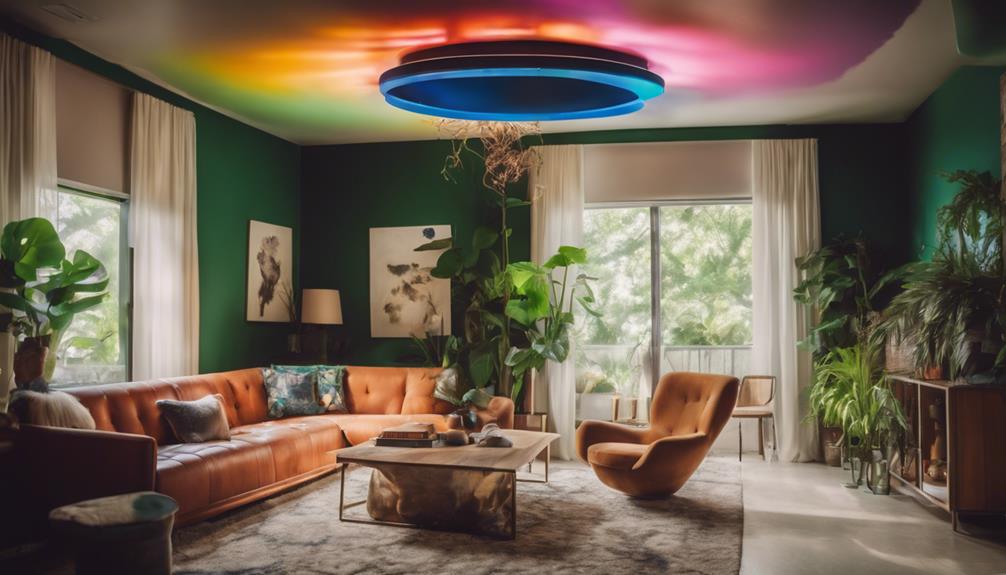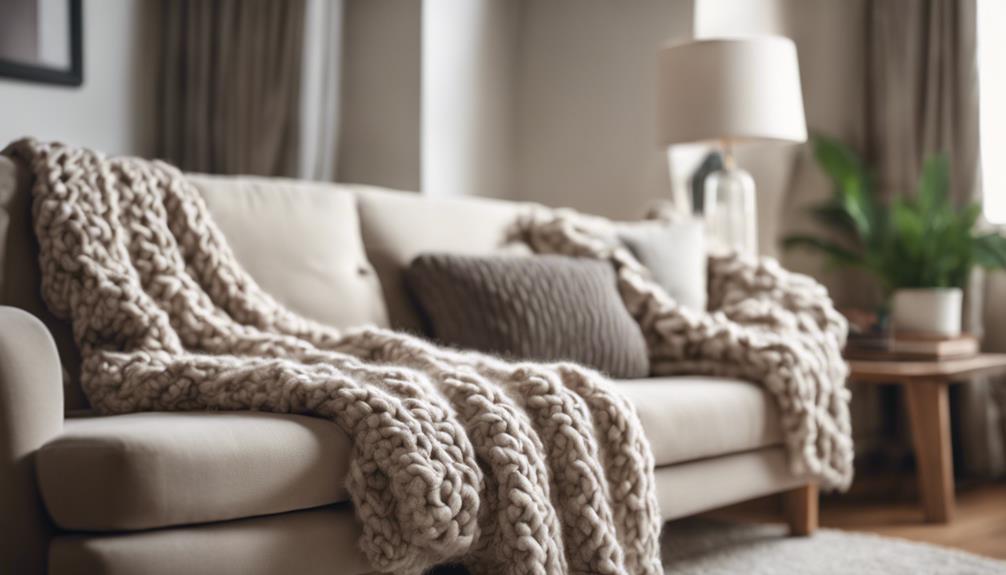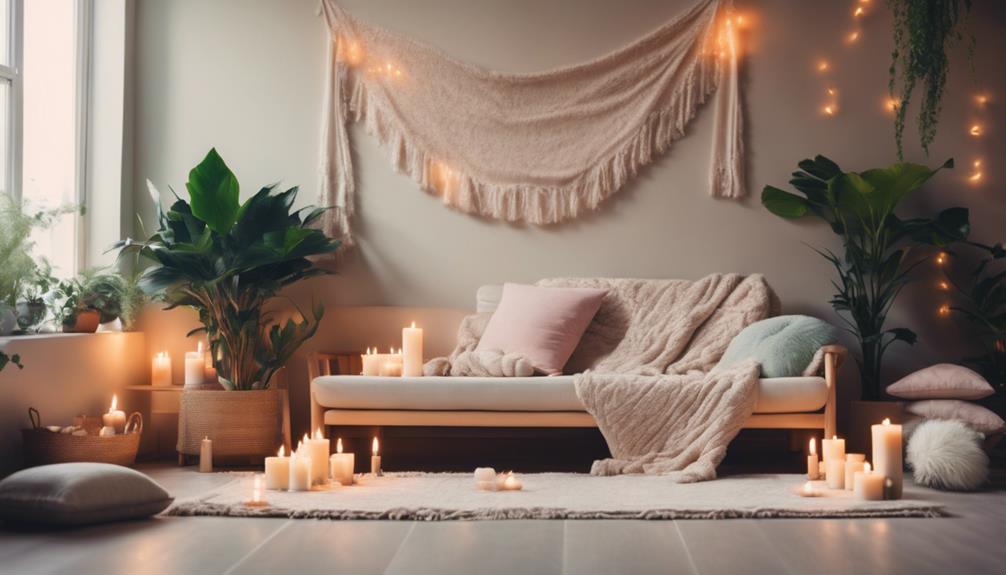Indonesian aesthetics in modern interiors blend traditional craftsmanship with contemporary design. You'll notice natural materials like bamboo and rattan creating warmth and sustainability. Bold color palettes, inspired by local textiles, energize the space, while handcrafted furniture adds character. The principle of Tri Hita Karana emphasizes harmony among humans, nature, and spirituality, promoting a tranquil atmosphere. Open spaces and large windows blur indoor and outdoor boundaries, maximizing light and ventilation. Cultural artifacts enrich the décor and tell local stories. By incorporating these elements, you create a uniquely vibrant atmosphere that reflects the beauty of Indonesia's rich heritage. You might find even more inspiration if you explore further.
Key Takeaways
- Modern Indonesian interiors blend cultural heritage with contemporary design, incorporating traditional elements like hand-carved furniture and local craftsmanship.
- Natural materials such as wood, bamboo, and rattan create warmth, sustainability, and an organic aesthetic in modern spaces.
- Vibrant color palettes inspired by local textiles use bold hues and earthy tones to enhance emotional response and energize interiors.
- The integration of art and artifacts, like traditional masks and handcrafted ceramics, showcases local craftsmanship and tells cultural stories.
- Principles of harmony and balance, emphasized by Tri Hita Karana, promote tranquility through thoughtful arrangement of textures, colors, and natural elements.
Overview of Indonesian Aesthetics
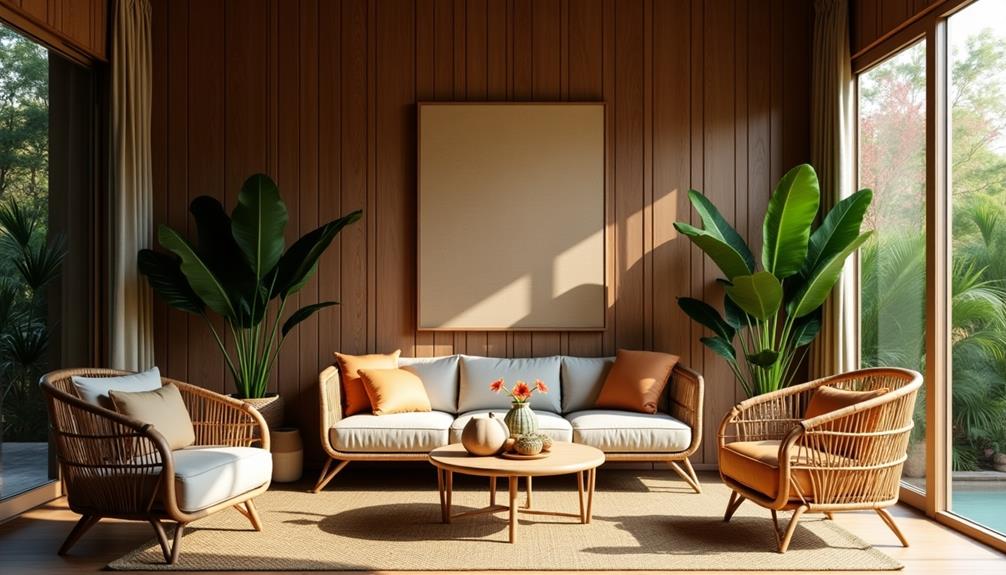
Indonesian aesthetics in modern interiors seamlessly blend the rich cultural heritage of Indonesia with contemporary design principles. You'll find that traditional elements play a significant role in this fusion, showcasing the unique artistry and craftsmanship that Indonesia is known for.
Hand-carved furniture and decorative pieces reflect the skilled artisanship, highlighting the importance of culture in every design choice. Incorporating Indonesian decorative pillows can add vibrant colors and intricate patterns to enhance living spaces.
Natural materials like wood, bamboo, and rattan are commonly used, creating a warm and inviting atmosphere that connects you to the environment. These materials not only add texture but also embody sustainability, a fundamental aspect of modern design.
The vibrant color palettes, inspired by local textiles and landscapes, further enhance the visual appeal of interiors. Earthy tones combined with bold accents evoke a sense of place and identity.
A key principle guiding this aesthetic is the concept of Tri Hita Karana, which emphasizes harmony and balance. This philosophy influences how spaces are arranged, fostering tranquility and a deeper connection with nature.
When you embrace these elements, you're not just decorating a space; you're celebrating Indonesia's rich heritage while creating a contemporary living environment.
Natural Materials in Design
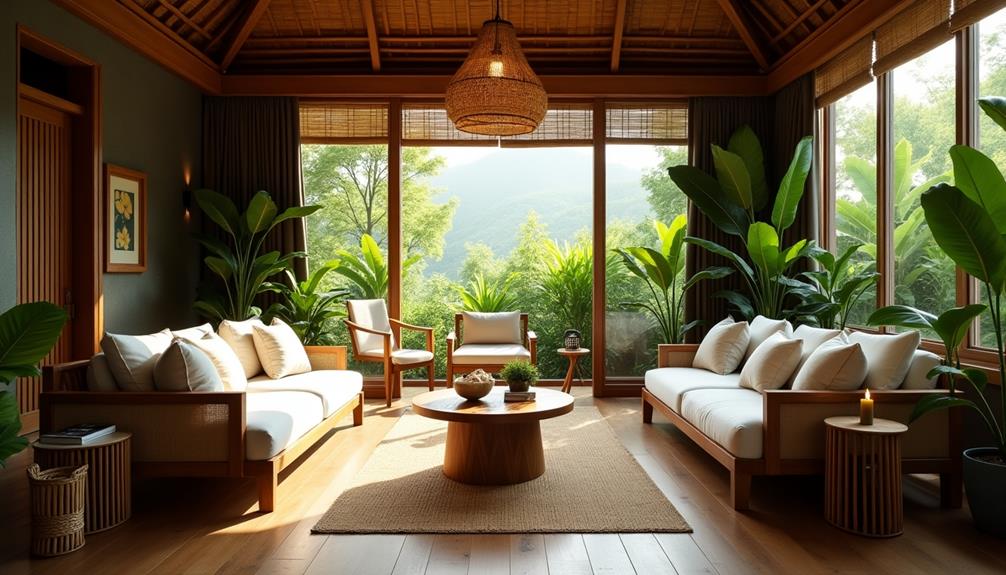
Natural materials like rattan and bamboo breathe life into modern interiors, creating an organic and eco-friendly aesthetic that resonates with your surroundings. By incorporating these elements, you not only enhance the visual appeal of your space but also embrace a sustainable lifestyle.
Balinese design characteristics emphasize the use of handcrafted wooden furniture made from durable tropical hardwoods, adding warmth and showcasing Indonesia's rich craftsmanship tradition.
You can further enrich your interiors with textiles featuring traditional batik and ikat patterns. These fabrics infuse your space with cultural identity and artistic flair while maintaining a connection to local artisans.
Consider integrating natural stone elements, such as volcanic rock or marble, to provide a sense of grounding that reflects Indonesia's diverse landscape.
When you prioritize the use of locally sourced natural materials, you support sustainable practices and reduce your environmental impact. Earthy tones found in these materials create a calming atmosphere, allowing you to feel more connected to nature.
In modern Indonesian interiors, the thoughtful use of natural materials not only enhances beauty but also fosters a deeper appreciation for the environment and cultural heritage. Embrace these elements to transform your living spaces into harmonious sanctuaries.
Vibrant Color Palettes
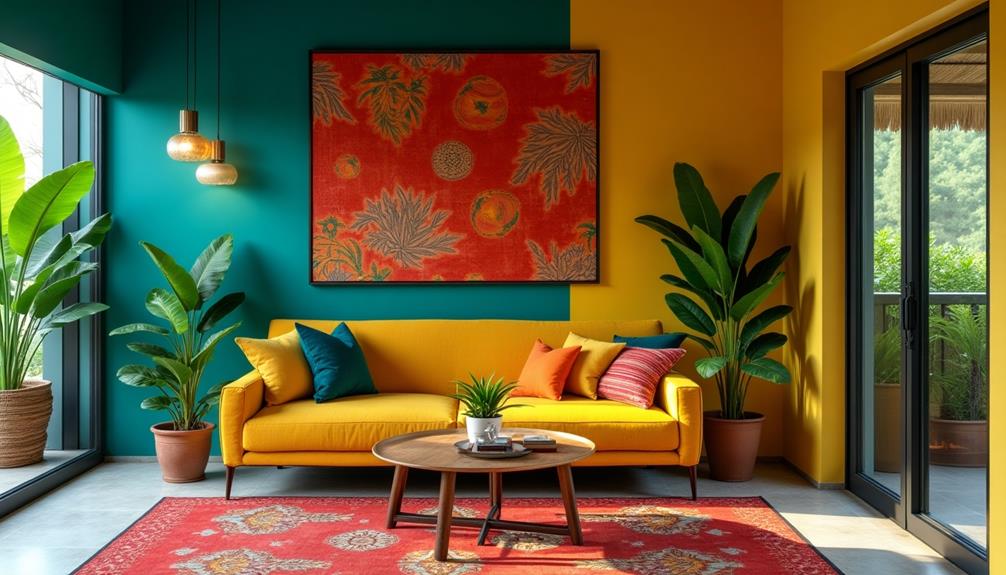
Incorporating vibrant color palettes can truly transform your modern interiors, infusing them with life and energy. Indonesian aesthetics celebrate bold hues inspired by local textiles and landscapes. You might choose deep reds, bright yellows, and rich greens to create lively, inviting spaces.
While vibrant colors energize, don't forget the calming influence of whites and blacks. White symbolizes purity and spiritual balance, while black grounds your design, creating harmony. Earthy tones like browns and beiges lay a warm foundation, allowing vibrant accents—such as turquoise and gold—to pop with cultural flair.
To illustrate these concepts, consider the following table:
| Color Category | Description |
|---|---|
| Vibrant Colors | Deep reds, bright yellows, rich greens |
| Earthy Tones | Browns and beiges for warmth |
| Traditional Motifs | Batik and ikat patterns in decor |
Integration of Art and Artifacts
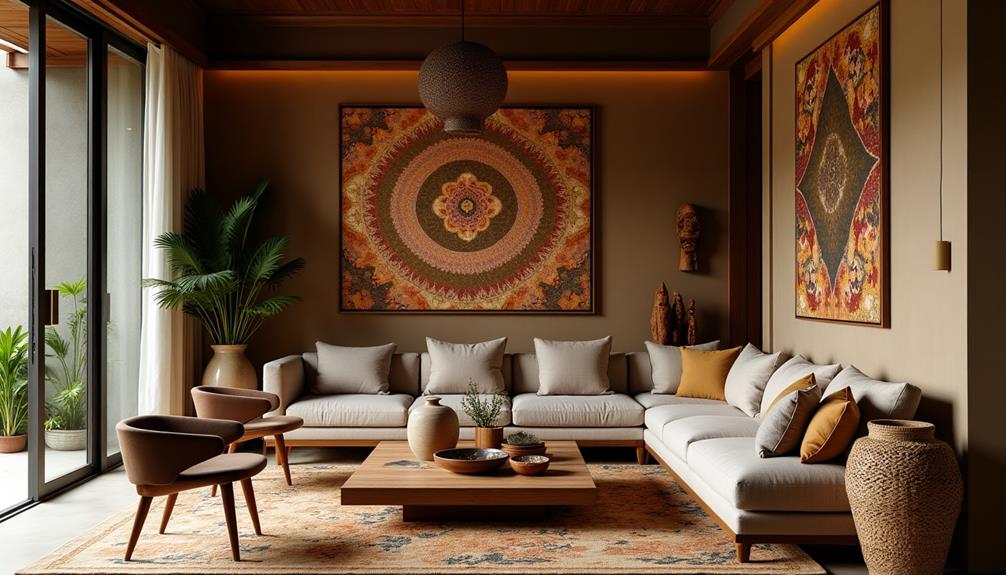
When you integrate traditional Indonesian artifacts into your modern interiors, you're not just decorating; you're telling a story. Each piece holds cultural significance and showcases local craftsmanship, adding depth to your design.
For instance, incorporating Indonesian decor masks can enhance the aesthetic appeal of your space while celebrating rich local traditions.
Cultural Significance of Artifacts
The cultural significance of artifacts in modern Indonesian interiors lies in their ability to convey deep-rooted traditions and narratives. When you integrate traditional artifacts like masks, sculptures, and textiles, you create a visual narrative that reflects Indonesia's rich cultural heritage.
Each piece tells a story, showcasing the craftsmanship and artistry inherent in local culture, which enhances the emotional connection to your space. Indonesian decor masks serve as striking focal points that not only enhance aesthetic appeal but also promote appreciation for cultural storytelling.
Traditional textiles, such as batik and ikat patterns, add vibrant colors while anchoring your design in Indonesian identity, celebrating its artistic history.
Incorporating decorative elements like handcrafted ceramics and wooden carvings highlights local craftsmanship, enriching the aesthetic appeal of your interiors and supporting local artisanship.
Storytelling Through Design Elements
Integrating traditional artifacts like masks and sculptures into your space creates a powerful storytelling experience that reflects Indonesia's rich cultural heritage.
These elements serve as visual narratives, inviting you to explore the diverse traditions and histories that shape the Indonesian aesthetic. Incorporating unique pieces such as Indonesian decor masks not only enhances your decor but also encourages appreciation for traditional craftsmanship.
By placing handcrafted pieces strategically, you evoke emotions and create a dialogue that bridges the past and present.
Incorporating local textiles like batik and ikat not only adds artistic flair but also conveys historical significance, enriching your design. Each piece tells a story, reflecting the craftsmanship and skills of local artisans.
This appreciation for traditional art fosters a deeper connection to the culture, making your interior more meaningful.
Additionally, the artworks and artifacts often embody themes of spirituality and nature, aligning with the principles of harmony and balance central to Indonesian aesthetics.
When you curate these elements thoughtfully, you enhance the depth of your space, allowing storytelling to flourish through design.
This integration of art and artifacts transforms your home into a canvas that celebrates the beauty and complexity of Indonesian culture, making every corner a conversation starter.
Highlighting Local Craftsmanship
Emphasizing local craftsmanship transforms your space into a vibrant tapestry of culture and artistry. By integrating traditional artifacts like masks, sculptures, and textiles, you create a visual narrative that mirrors Indonesia's rich cultural heritage. Each piece tells a story, allowing you to celebrate the diverse traditions that shape the nation's identity.
Incorporating elements from traditional Indonesian style home decor enhances the aesthetic appeal of your interiors, allowing natural materials and intricate designs to shine. Artisans showcase their intricate craftsmanship through techniques such as hand-carving and weaving. These methods add unique character to your contemporary interiors, making them feel more personal and authentic.
Using local materials like rattan and bamboo not only supports local craftsmanship but also brings warmth and a sense of place to your design. Incorporating storytelling elements through decorative pieces invites deeper appreciation for Indonesian traditions. It provides insights into the country's artistic history, fostering a connection between the past and present.
The blend of traditional art with modern design principles creates a harmonious balance that honors both heritage and contemporary aesthetics.
Principles of Harmony and Balance
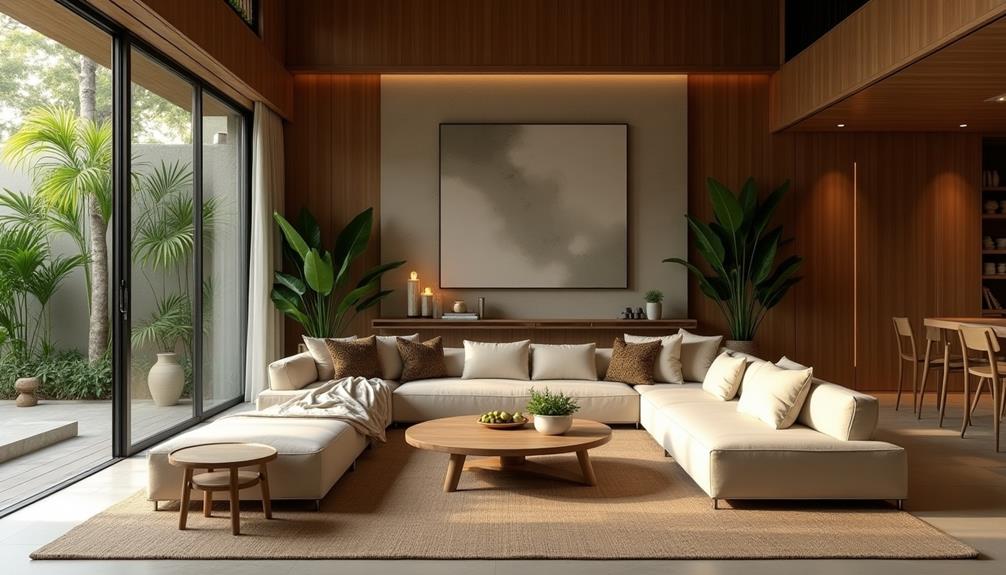
Harmony and balance are essential in Indonesian interior design, creating spaces that feel both serene and inviting. A core concept guiding this aesthetic is Tri Hita Karana, which emphasizes harmony among humans, nature, and the divine.
You'll notice that the arrangement and selection of elements within a space reflect this principle, fostering an atmosphere of tranquility. Traditional Indonesian housing often showcases these principles through its use of local materials and elevated structures, further enhancing the connection to nature and community traditional Indonesian housing.
Achieving balance involves a thoughtful combination of textures, colors, and materials. By using natural materials like wood and stone, you enhance the aesthetic appeal while reinforcing the connection between indoor spaces and nature, promoting peace.
Furniture arrangement also plays a vital role; it focuses on flow and accessibility, allowing easy movement and interaction while maintaining a harmonious visual layout.
To further enhance this sense of balance, consider incorporating elements such as indoor gardens or water features. These additions help create a seamless integration of indoor and outdoor spaces, which not only enriches the overall aesthetic but also deepens the feeling of serenity.
Embracing Open Spaces

In Indonesian modern interiors, you'll find that embracing open spaces means maximizing natural light and blurring the lines between indoor and outdoor living.
This design approach promotes an airy ambiance, making your home feel more expansive and connected to nature. By incorporating large windows and sliding doors, you create a seamless flow that enhances your overall well-being.
Additionally, using natural materials and vibrant colors reminiscent of Indonesian wedding decor can further enhance the warm and inviting atmosphere of the space.
Maximizing Natural Light
Natural light transforms spaces, creating an inviting atmosphere that feels both vibrant and serene. In modern Indonesian interiors, maximizing natural light is key. You'll often find large windows and sliding doors that not only allow sunlight to pour in but also create a seamless connection to the outdoors.
This design choice enhances the sense of openness, making your home feel more expansive. Many designers, such as Mahallati Interiors, focus on blending natural elements with modern luxury, further enhancing the role of light in their designs.
Open floor plans promote free movement and unobstructed views, contributing to an airy ambiance. To further amplify the effect of natural light, consider incorporating reflective surfaces like mirrors. They can make your living space feel even larger and brighter.
Architectural elements such as overhangs and pergolas provide shade while letting sunlight filter through, striking a balance between comfort and brightness.
Incorporating natural materials, like bamboo and rattan, complements the influx of light beautifully. These elements add warmth and richness, reflecting the essence of Indonesian culture.
Blurring Indoor/Outdoor Boundaries
Creating a seamless connection between indoor and outdoor spaces is essential in modern Indonesian interiors. By blurring the indoor/outdoor boundaries, you can create an environment that embraces nature while enhancing the overall aesthetic. Large windows and sliding doors play a vital role, allowing natural light to flood your home and providing unobstructed views. Open floor plans encourage free movement and a sense of freedom, reinforcing this connection.
To integrate natural elements effectively, consider the following:
| Element | Description |
|---|---|
| Large Windows | Maximize natural light and views |
| Sliding Doors | Create easy access to outdoor living areas |
| Tropical Greenery | Infuse life and color, enhancing tranquility |
| Water Features | Add serenity and a soothing ambiance |
| Natural Materials | Use bamboo and rattan for organic aesthetics |
These features not only enhance visual appeal but also promote ventilation, making your space comfortable and harmonious. By incorporating these design principles, you'll enjoy a living environment that celebrates Indonesia's tropical climate, inviting nature into your daily life.
Promoting Airy Ambiance
Emphasizing an airy ambiance is key to modern Indonesian interiors, where open spaces foster a sense of freedom and tranquility. You'll often find open floor plans that encourage free movement and maximize natural light, creating that liberating feel you crave in your home.
Large windows and sliding doors blur the lines between indoor and outdoor spaces, enhancing the connection with nature and reinforcing the airy ambiance. This concept is particularly prominent in tropical villa plans, where the design prioritizes seamless indoor-outdoor flow.
Integrating tropical greenery and water features adds to this serene atmosphere, making the environment feel alive and welcoming. You'll appreciate how indoor plants not only beautify your space but also contribute to a natural, soothing vibe.
Using natural materials like bamboo and rattan in your furniture promotes lightness and comfort, making your home feel like a cozy retreat.
This focus on airy layouts aligns with Indonesian aesthetics, particularly the principles of Balinese design, which emphasize ventilation and a seamless flow throughout the space.
Ultimately, embracing open spaces allows you to create a tranquil oasis that reflects the beauty of nature, elevating your living experience while celebrating the essence of Indonesian design.
Cultural Influences in Modern Interiors
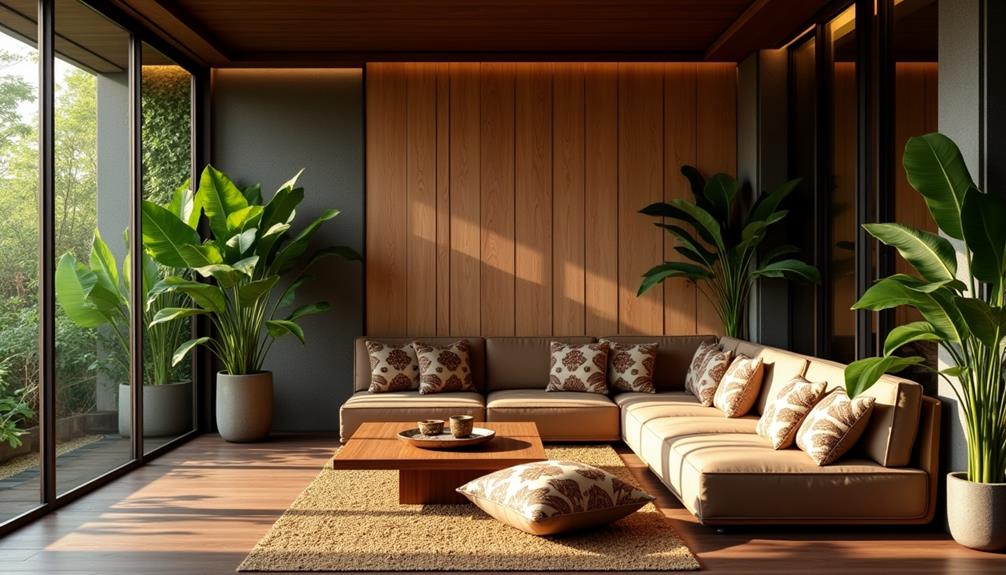
Indonesia's rich cultural heritage profoundly shapes modern interior design, blending traditional elements with contemporary aesthetics.
When you step into a modern Indonesian space, you can feel the connection to the past while enjoying the comforts of today. The use of culturally rich materials and designs creates a unique atmosphere that honors tradition.
- Batik and ikat textiles drape elegantly over furniture, adding depth and character.
- Natural materials like bamboo and rattan offer warmth and sustainability, showcasing Indonesia's abundant resources.
- Earthy color palettes, inspired by local landscapes, are complemented by vibrant accents that brighten the space.
- Open floor plans seamlessly integrate indoor and outdoor areas, promoting natural ventilation and harmony with nature.
- Traditional masks and sculptures serve as striking decor, narrating stories and enriching the aesthetic experience.
Sustainability in Indonesian Design

Sustainable design practices are becoming a hallmark of modern Indonesian interiors, showcasing the country's commitment to eco-friendly principles.
You'll find that Indonesian designers are increasingly incorporating eco-friendly materials like bamboo, rattan, and reclaimed wood, which not only promote sustainability but also celebrate local craftsmanship.
In office settings, there's a strong emphasis on creating paperless environments, reflecting a commitment to reducing waste and fostering sustainable practices.
Designers are also integrating energy-efficient solutions, such as natural ventilation and solar energy systems, minimizing the environmental impact of their projects.
Moreover, you'll notice a growing trend toward multifunctional spaces that maximize efficiency.
This approach reduces the need for additional resources and aligns perfectly with sustainable design principles.
Indoor greenery and biophilic design elements further enhance the aesthetic appeal while improving air quality and overall well-being in modern interiors.
Frequently Asked Questions
What Is Balinese Interior Design Style?
Balinese interior design style blends natural materials like wood and stone, creating warmth. You'll appreciate open-air concepts that connect indoors and outdoors, vibrant colors symbolizing energy, and serene nature-inspired elements that enhance tranquility in your space.
Conclusion
Incorporating Indonesian aesthetics into modern interiors creates a vibrant and harmonious space that tells a story. As the saying goes, "Home is where the heart is," and by blending natural materials, bold colors, and cultural artifacts, you can craft an inviting environment that resonates with warmth and authenticity. By embracing open spaces and sustainability, your home can reflect the beauty of Indonesia while providing a serene retreat that nurtures both body and soul.


